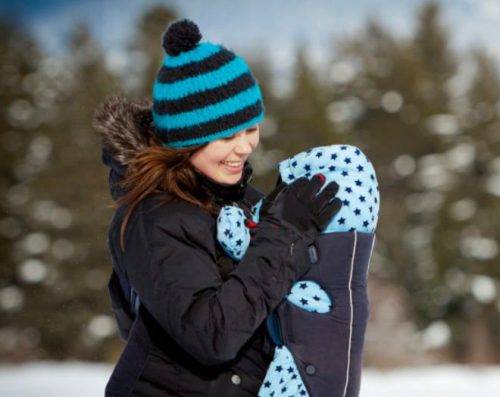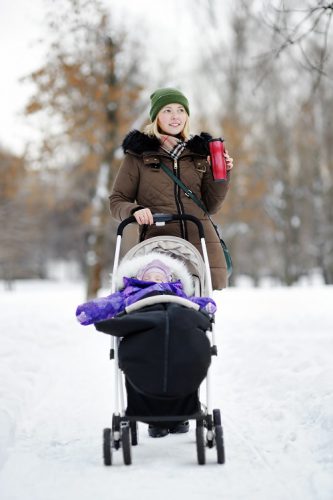Winter can be an anxiety-provoking time for new Military parents who want to keep their babies snug against the dropping temperatures and impending snow. It can be tempting to hole up at home, but babies need fresh air. Plus, being outside helps infants become accustomed to day-and-night cycles, which can calm fussiness.
That being said, new parents should follow some safety precautions in the winter because babies aren’t able to self-regulate their core temperatures like older kids and adults can. This means limiting outdoor time to trips to and from the front door to the car and adhering to the following tips to keep your baby safe and warm.
1. Dress Your Baby in Layers

This may seem like a no-brainer, but, if it’s cold enough for you to wear a jacket, your baby should be wearing one, as well. In fact, bundle them up in several layers like leggings and a body suit, pants and a long sleeve shirt, and a jacket, hat, mittens, and boots. This will keep them cozy when outside, but allow you to easily remove layers when indoors to keep them from becoming too warm. Breathable fabrics such as cotton are best because they won’t trap too much heat and cause your baby to become uncomfortable.
2. Remove Your Baby’s Coat in the Car

It may seem silly to bundle your baby up just to remove their coat in the car, but it’s an important safety precaution. Puffy coats can put too much material between your baby and their car seat straps, which increases the chance of injury in an accident. Instead, strap your baby into the car seat and then layer blankets on top. You can also pre-warm your car to keep them cozy.
3. Share Your Warmth

Carriers allow you to use your body heat to keep your baby warm in cold weather. Even if you are wearing your baby in a carrier, be sure to keep their head and feet covered because that’s how they lose heat. Also be sure their face is not pressed against your chest or clothing to keep their airway free.
4. Cover Your Baby’s Stroller Carefully

It may seem like a good idea to cover your baby’s stroller with a blanket or plastic cover, but these can actually hinder air flow to your baby inside. Instead, see if your stroller has a special cover fitted to the brand that will protect your baby against the cold while allowing air to circulate. Another option is to simply bundle your baby in a jacket, hat, mittens, and boots and tucker them under a blanket up to chest height. Also try to walk against the wind, if possible.
5. Keep the Indoor Temperature Cool

You don’t have to crank up the heat to keep your baby comfortable. In fact, keeping your house on the cooler side — between 68°F and 72°F during the day and 65°F and 68°F while the baby is sleeping — is better for them. Indoor heating has low humidity which can dry out your baby’s skin.
6. Keep Your Baby’s Skin Soft

Cold outdoor temperatures and indoor heating are dry, which can contribute to itchy, scaly skin, as can long, hot baths. Prevent your baby’s skin from drying out by keeping indoor air cool and bathing them every few days in warm (but not hot) water for no more than 10 minutes. After you dry off your baby, apply a good moisturizer and continue to apply throughout the day as you see fit. Call your pediatrician if your baby’s skin becomes red or irritated.
7. Be Wary of the Warning Signs

Bring your baby inside right away if they start shivering or their hands, feet, and face turn red and cold or pale and hard. Don’t rub their skin to warm it which can cause damage to cold skin. Instead, use warm washcloths to gently reheat their skin and put your baby in warm and dry clothes. Call your doctor if they don’t improve in a few minutes or if they are showing signs of lethargy, non-responsiveness, or have blue lips or face.



